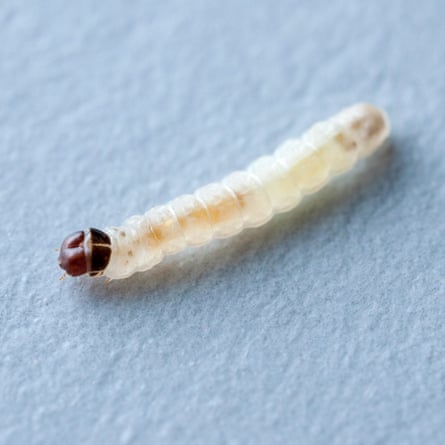When Janine Christley moved into her new house, she thought buying woollen carpets would be the sustainable option. She had the stairs and two floors of her cottage carpeted, at a cost of thousands of pounds. Then the moths moved in. She first noticed them about four years ago, just a few at first. But then they started devouring the carpets, creating big bare patches. Gradually, Christley has had to rip them up and replace them with synthetic carpet. “I’ve still got woollen carpet in my room and the front room, but there are big holes where they’ve eaten it away,” she says. To a family of moths, it turns out, a wool-carpeted house is essentially an all-you-can-eat restaurant.
“Of course, they’re into clothes as well,” she says. They have eaten woollen jackets and gorged on the bags of wool she keeps for felting projects – as well as the finished works themselves. She has avoided chemical controls, but clothes regularly go into the freezer in an attempt to kill the moths’ eggs. “I’m constantly checking where they might be,” says Christley. “I go into the wardrobe and shake all my clothes regularly because they like to be dark and undisturbed. I check under furniture, swat any I can find. I’m always jumping up to try to catch them; I see them flying around. I’m encouraging spiders in my house now; they’ve got lots of cobwebs and I’m trying to get them to catch the moths.” It has been frustrating – and expensive. “And it’s all been a waste of time.”
In houses up and down the country, there is a war being waged against clothes moths. Among other things, it features chemical weapons, smoke bombs and armies of tiny, parasitic wasps. While virtually all the 2,500 or so species of British moths are ecologically beneficial, there are two that eat textiles and objects derived from animals, including wool, silk, skin and fur. They will munch through antique rugs and treasured cashmere.
Unlike the many moths that are in decline, these moths – the webbing (or common) clothes moth and the case-bearing clothes moth – are believed to be increasing in numbers. Moth traps used by English Heritage at its properties and storage sites found a 216% increase in the number of webbing clothes moths caught between 2012 and 2016. In 2017, English Heritage launched a study called Operation Clothes Moth, giving out traps to visitors to place in their homes and report back on. “We knew the numbers were rising in National Trust and English Heritage houses because we’ve got regular monitoring programmes,” says David Pinniger, an entomologist who has worked with many museums and historical institutions. “But we’ve also got a lot of anecdotal evidence that a lot of households have seen a huge increase as well. Operation Clothes Moth showed it was more widespread than we probably thought.” Flats and properties built before 1950 were more likely to be affected.

There are a range of reasons for the rising numbers. Hotter winters are almost certainly to blame, plus the fact we keep our homes so warm. Our housekeeping is probably not what it once was, either. Washing clothes at a lower temperature saves energy, but it means eggs are not being killed. This is less of a problem if you wear something regularly, but lots of us have so many clothes that outfits go unworn for months or even years. “It’s thought also that, nowadays, wool and other materials are less often treated with insecticides, so you don’t have the residual effect that may have existed decades previously,” says Nigel Blades, a preventive conservation adviser for the National Trust. “It’s not always a wise use of insecticides, but it did have the effect of killing off moths.” In 2008, the EU banned the use of naphthalene, a toxic, flammable chemical long used in mothballs.
There has also been a shift back to natural fibres in carpeting and clothing, which has created food for the pests. “One of the things that worries me is the push for natural fibres for insulation,” says Pinniger. “Wool insulation is great environmentally, but if you stick wool up in your attic you’re going to get moths in it. Even worse, I know one house where they blew wool in cavity walls. They can’t get it out and they’ve got moths – they’re going to have to live with moths the whole time they live in that house.”
The previous owners of Emma Harrison’s house warned her there could be a moth problem when she moved in five years ago. She cleaned the house from top to bottom and put insecticides down. It didn’t work. She discovered her clothes were being ruined, including a treasured (and expensive) coat. Carpets were devoured and had to be pulled up. She has tried hanging up bags of herbs and cedarwood, but nothing has worked. “The only thing I’ve got left is either burn down my house or get the pest controllers in,” she says. “We’ve given up on repainting because all the walls are spattered. Every morning when I wake up there are about 10 or 12 on the wall. I don’t like killing creatures, but they’re a menace. I had a scarf that my grandmother gave me and that’s now mothridden, but I can’t bring myself to get rid of it. Every time you’ve got rid of them, they appear again.”
That is often around this time of year. Moths will happily breed in warm, centrally heated homes throughout the year, says Pinniger, “but there is a peak of adult emergence usually in April and May, and often another one in late August/early September when you get another generation through. Some of the museums I work with, there are moths all year round because the temperatures are constant, and we’re getting at least three generations a year. Each female can lay 100 eggs. That’s a pretty big potential increase.”
Moths don’t eat clothes; their larvae do. They hatch within a few weeks of being laid. “When they first hatch, they’re only a millimetre long and they burrow into your clothes, so you don’t see them. It’s not until they get bigger that you see the evidence,” says Pinniger. In ideal conditions, he says, hungry larvae will take three months to mature into moths, but it could take up to nine months. That is a lot of munching time. “They don’t eat quickly, but when you’ve got a lot they can produce some quite nasty damage.”
It is believed that case-bearing moths have been in the UK since at least Roman times. “We don’t know whether the Romans brought them over when they invaded, although we know they have been around a long time in the UK and northern Europe,” says Pinniger. The webbing clothes moth is thought to be a much more recent arrival; it is not described in scientific literature until the Victorian era. “The theory at the moment is that it probably came over from South Africa in Victorian times when they imported a lot of skin and feathers.” They like the warmth – they thrive in heated buildings and aren’t normally able to complete their life cycle outdoors in the UK. “Whereas we know the case-bearing clothes moth can live in birds’ nests,” adds Pinniger.
Clothes moths can’t fly very far, so it is unlikely that they come into homes through open windows, although this is possible in urban areas. They are almost certainly introduced to a home on something such as a vintage blanket, an antique rug or a sweater from a charity shop. “In the natural world, they live in things like birds’ nests and they’d be eating feathers and the remains of birds,” says Blades. “If a bird falls down a chimney, or you’ve got a birds’ nest in the chimney, that can be a source.” They may have lived for years in your house without you noticing. “And then suddenly the conditions are right and you get a population explosion,” says Pinniger.

The National Trust uses pheromone traps as part of its monitoring programme – this doesn’t control the population, but gives an indication of the scale of the problem. The main approach for controlling numbers is regular cleaning. “Often that can be enough,” says Blades. “In some cases where we need to go beyond that, we use a commercial product called Constrain, which has a residual effect for a number of months. We use that to treat nooks and crannies where moths might like to hide away.” The National Trust has done a trial using tiny parasitic wasps, which seek out moths’ eggs and lay their own inside, hatching new wasps. (These wasps aren’t harmful to humans, don’t live long and are so small that you would barely notice them among house dust.) This was carried out in one property, but Blades says it isn’t yet clear how effective it has been.
When an object such as a rug or costume has been affected, it is treated in a commercial chest freezer, where it is cooled to -30C. Mobile heat chambers are used for furniture with upholstery, where pieces are heated to about 50C.
Dee Lauder, a pest control manager at English Heritage, has noticed a significant increase in moths in the past 10 years and particularly in the past five. “The best way of keeping on top of it is very good management and housekeeping,” she says. “We have collection-care assistants who are trained to go into the houses and carry this out all the time for us. These are increasingly the things you need to concentrate on in the average home as well. It’s not a case of running a vacuum over the carpet and thinking that’s done – at least once a month, and particularly during the spring and summer months, you need to thoroughly go round the edge of the carpet with a nozzle on the vacuum. Take out items in your wardrobes and give them a shake out because moths don’t like disturbance.” If you have carpet underneath your cupboards, you might want to think about getting rid of it, she says. “If you’ve got heavy items of furniture, and sofas, you need to be pulling them out at least once a month and thoroughly vacuuming underneath. This is how we keep on top of it in historic houses.”
She recommends people store seasonal clothes in vacuum-sealed bags. “You can’t really do that with historic costumes. We’ll keep them boxed up and the conservators check them once or twice a year and make sure nothing is in them. Because of the significance of the collections, you cannot start spraying chemicals on them, which could cause more damage than the larvae themselves. Our approach has always been trying to do it in the most natural ways possible.” It is constant, she adds. “We never get a chance to relax.”
Aerosol sprays and smoke bombs will kill moths, but if they have already laid their eggs then it is too late (they would soon die naturally anyway). Museums that Pinniger works with use insecticides concentrated around the edges of carpets, “which work reasonably well against the larvae”. Lavender sachets and cedarwood blocks may repel some adults for as long as the scent is strong. “But if the moth gets past your defences and lays eggs, it has no effect on the larvae.”
The only things that work longer-term, he says, are removing the food sources, making an effort to clean thoroughly (including sweeping chimneys to remove birds nests and debris), regularly opening and disturbing dark hiding places such as drawers and wardrobes, and killing eggs by freezing clothes. “When you look back at early housekeeping manuals, they say you should keep your fur coats and thick jerseys in the cold store over summer.” Using a freezer as a kind of wardrobe isn’t necessarily as wacky as it sounds. Last year, the TV presenter Kirstie Allsopp said she keeps a small freezer next to her washing machine for her scarves and woollen coats. “I constantly put things in to freeze the eggs and stop them in their tracks,” she said. “I circulate the items that go in there to be as sure as possible that moths won’t suddenly strike.” Moths, she said, “are the bane of my life. I have spent a huge amount of money on products and pest controllers and have learned the hard way that the only way to keep your home moth-free is constant vigilance.”

Is there any way we can reframe our relationships with clothes moths? “I would suggest avoiding the chemical blitzkrieg that we tend towards whenever we notice something alive around us, which we never tend to win,” says Rob Dunn, a professor of biology at North Carolina State University and the author of Never Home Alone, a book about all the tiny beings with which we share our homes.
The idea that in the absence of a moth infestation your clothes are “clean” is wrong. “All of your clothing is covered with smaller species that you don’t see,” says Dunn of the microbes that live on your clothes, especially those made from natural fibres. “They’re busy living on your clothes, slowly breaking it down. So, even when you don’t have moths, the idea that your clothes last for ever is an illusion. You’ve also got your skin bacteria that wait for you to put clothing on and then they metabolise your sweat. With that motley crew, the clothes moth is the most charismatic of the bunch.”
He suggests that, instead of reaching for the insecticide, we pay attention to moths. “They remain incompletely studied. See if you notice something that nobody has seen before. In and of themselves, they’re pretty fascinating species that have figured out a way to eat stuff that other species can’t eat. They’re beautiful, they fly around ephemerally; learn to enjoy that. You don’t want them devouring all your clothes, but once they’re there, it’s worth a moment to reflect on their loveliness.” Can that really make up for a treasured cashmere sweater that has been lost, gobbled by the beasts? He laughs. “Maybe not.”

Comments (…)
Sign in or create your Guardian account to join the discussion